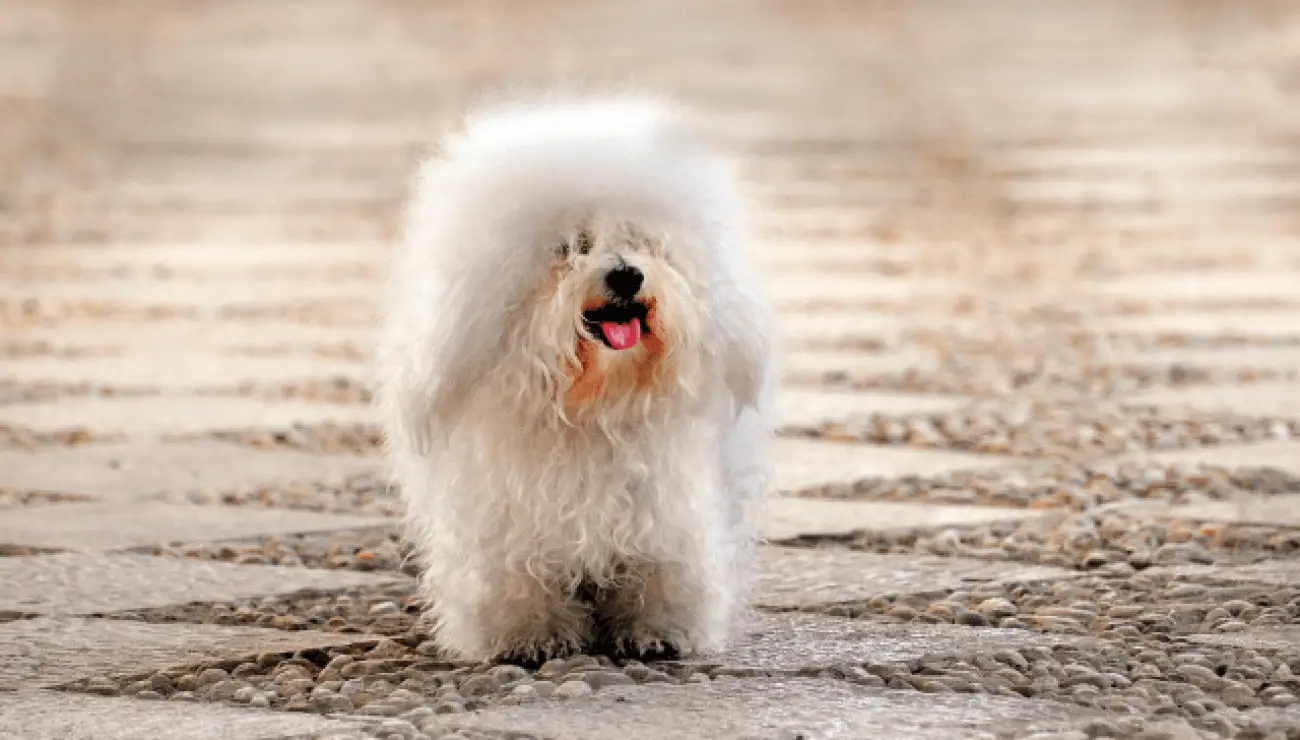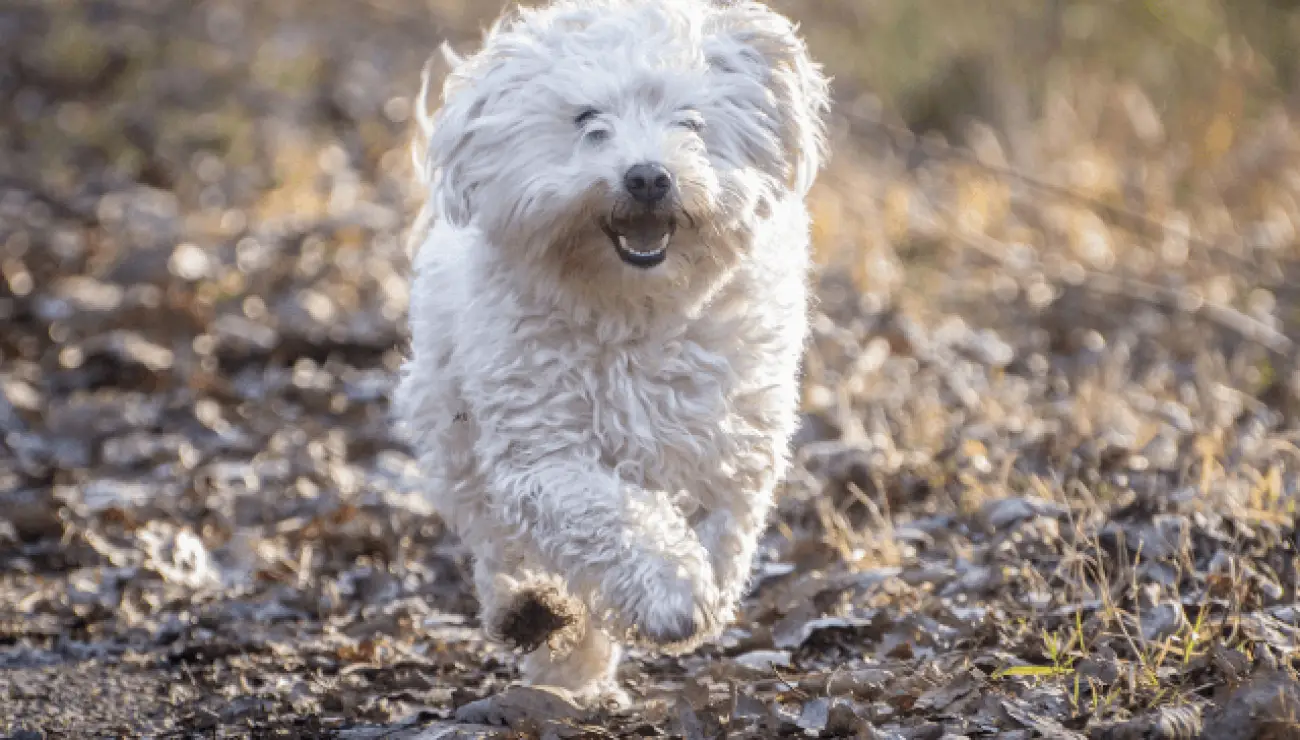Bolognese
The Bolognese is a small breed that comes from the Bichon family. They are true companion dogs that are the happiest when surrounded by their family. This companion breed is best suited for indoor living and will surely win you over with its lovely temperament and beautiful white fluffy coat.
The Bolognese developed as a breed centuries ago in the Italian town of Bologna. Some of the wealthiest Italians owned and bred this breed. These dogs were a status symbol and companions to the noblest of families.

Height:
9,8 - 11,8 in (25-30 cm)

Weight:
5,5 - 8,8 lb (2,5-4 kg)

Origin:
Italy

Life Expectancy:
12-14 years
Dog Breed Characteristics
Appearance
Bolognese dogs, with their soft, slightly tufted coats, feel and look like fluffy cotton balls when they cuddle up on your lap (which, by the way, is one of their favorite places to be). While no dog is entirely hypoallergenic, Bolognese has long and wavy coats that don't shed much, making these dogs ideal pets for mild allergy sufferers.
Their coats are unshaped and white or ivory. Many owners, however, keep their pets' coats shorter and leave an untrimmed "mop head." However, more frequent grooming is required if the Bolognese has a full coat.
Bolognese dogs are small, with stocky, square bodies that weigh 5.5–9 pounds and stand 10–12 inches tall. They are occasionally mistaken for Maltese; the dogs are similar due to their small stature, flowing white locks, and gentle demeanor. On the other hand, Bolognese are slightly larger than their Maltese cousins, and their unshaped coats can give them an odd appearance.
The adorable Bolognese also have round, black eyes paired with a black nose and nails. They have feathered tails that should ideally be curled up over the dog's back.

Temperament
The Bolognese was developed from the start as the best possible companion dog. They develop powerful bonds with the owners they choose and despise separation from them. They are often reserved towards strangers and will bark at anything new, unexpected, or strange. Despite their diminutive appearance and soft demeanor, they are clever dogs with an aptitude for learning. Training should be provided to maintain their active brains.
Grooming
The long Bolognese dog's coat is prone to tangling and must be combed daily, with special attention paid to the stomach, behind the ears, and the legs. Because they barely shed, dead hair must be removed through brushing. Although puppies are easy to wash, dry, and groom, it is a good idea to get them used to the grooming table, bathing, and visits to a professional grooming salon to keep them clean and looking their best.

They will also need their teeth brushed at least three times a week. Check their ears for signs of infection and redness, bathe them every 4-5 weeks (more if they live inside), and clip their nails if they don’t wear them down naturally.
Exercise needs
Bolognese is not that active, so it doesn’t require a lot of daily activities to be happy. They are great apartment dogs, and a few walks will do the trick and keep these dogs happy and satisfied. Playing games like hiding and seek, chasing balls, or learning new tricks can all be a fun way for them to spend energy.

Training
The Bolognese is simple to train with positive reinforcement and should be trained because they are surprisingly smart and calculated. Even though they are small, the Bolognese is still a dog and will be a happier dog if given some mental stimulation as well as regular physical exercise.
They can be challenging to potty train, which means you could potentially have to deal with accidents in the house longer than with other breeds. You should teach these dogs how to walk on a leash correctly and get them used to their crate. Crates can assist you in housebreaking your Bolognese puppy more quickly.
Socialization
There are many ways you can socialize your Bolognese, and the most important thing to do is to get your dog familiar with different situations they can find themselves in. Take your dog to dog parks where they can meet other dogs and people. They can learn to react accordingly and understand that they don’t need to be scared of strangers and other dogs.
Bolognese and kids
Early socialization and proper training can teach them to behave even when children are around. Their temperament makes them more suitable for families with slightly older kids. However, Bolognese will not tolerate aggressive behavior towards them or even between other children and may stop their quarrel before it escalates.
Children should never be left alone with any dog, no matter what breed it might be. You should make sure that your children understand how to approach dogs of this breed and safely interact and play with them.

Bolognese and other animals
These dogs get along just fine with strange dogs and animals. However, in some cases, they can be a bit standoffish, even with much larger dogs. Correct and early socialization is essential for your dog to behave well.
Health problems
Like any other dog breed, the Bolognese can potentially develop health problems. If you are buying a dog, make sure the breeder can provide you with the necessary health tests and guarantees. Always ask to see the results of tests from the puppy’s parents. The Bolognese is generally considered a healthy breed that can live 12-14 years.
To be sure that your dog will be healthy, always buy them from a responsible dog breeder who regularly tests their breeding dogs to secure that their puppies will be healthy as well. The only major concern in this breed is patellar luxation.
Bolognese breeders
Before searching for the Bolognese breeders, make sure that this is the right breed for you. These dogs require a lot of attention and are a true companion breed. They like nothing more than to spend time with their owner and their family. Make sure you have enough time to spend with your dog and see if your dog can come with you wherever you go.
If you think you can provide your new dog with all of that, you can start looking for reputable and registered Bolognese breeders. Ask the breeder to present you with the necessary breeding documents and registrations. Ask them about this breed and ask for advice. Great breeders will be glad to answer all your questions and be happy their dogs are going to a knowledgeable household.
World Dog Finder team

Updated at31.08.2023.
Breed History
The Bolognese, as well as the Maltese, Lowchen, Coton de Tulear, and Bichon Frise, are all a part of the same breed family - the Bichons. They are pretty similar, but the Bolognese remains a unique breed with its own rich and colorful history. The Bolognese has a noble origin and was extremely popular among the Italian aristocracy.
This breed is closest to the Maltese, but their exact origin is still a bit of a mystery. It is unclear which breed is older, the Maltese or the Bolognese. However, it is known that this breed got its name after the Italian town of Bologna, where its existence was recorded as early as the 13th century.
These dogs have been a motive in many works of art by many famous artists such as Watteau, Gosse, and Goya. Works of art depicting this breed have been dated back to the 1600s. Since this breed was popular among the wealthiest Italian families, it is no wonder that many world leaders and royalty got these dogs as gifts. Some of these royals and nobles include the likes of the Austrian Empress Maria Theresa, Catherine the Great, and Madame de Pompadour.

The Bolognese was very popular in the European mainland but was brought late to the United Kingdom. The first Bolognese were imported to the UK in 1990 by Elizabeth Standard and made a debut at a conformation show the same year. In 2002 these dogs made a debut in the famous Crufts dog show.

















Share